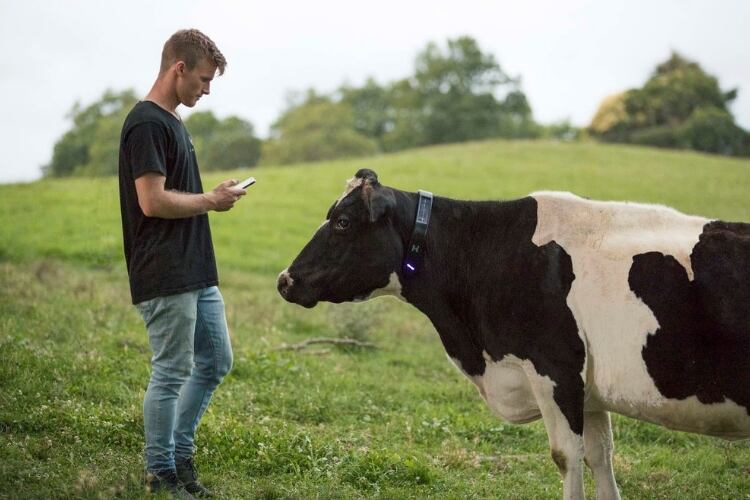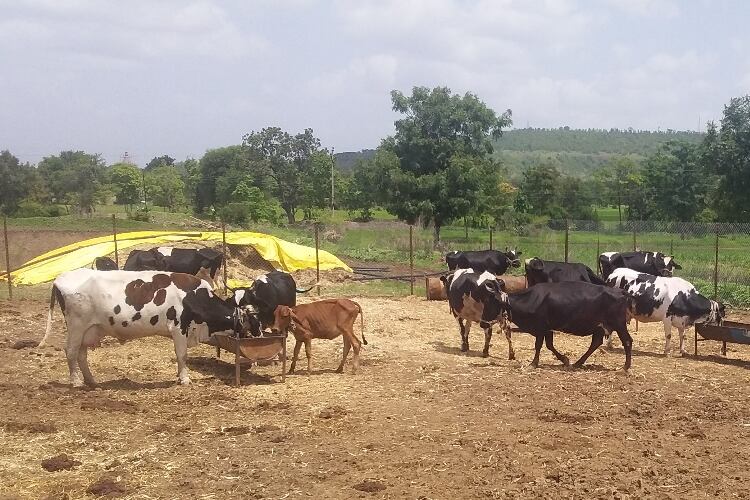The start-up, at three-and-a-half years old, is quite mature by New Zealand standards, and especially in terms of ag-tech start-ups. It is aiming to launch fully within the next year or so, and is currently in field trials at several Kiwi farms.
At the core of its business is a solar-powered collar worn by cattle around the clock. This smart collar is GPS-enabled to self-herd cows. The device can also send data about cows’ behavior, emotions and health to a farmer's mobile phone.
“Farming is really just a whole lot of manual processes. This presents an opportunity for us because we believe we can do so much better for the animal,” continued Piggott.
“We don’t want to be an iteration on ag-tech or farming in general. We don’t want to make small improvements; we wanted to completely change how you run a farm.”
The collar calls on Pavolvian theory, whereby an animal can be conditioned over time to complete a task from being given a regular stimulus. In the case of Halter’s collar, the device makes a warning sound, for example, when a cow approaches a boundary, teaching it how far it can move into an area.
Halter can also help move a herd of cows together from pasture to a shed, or pick out individual cows if they are sick, lame or on heat. Farmers can also program schedules to have cows meet them at the milking shed, and set up virtual fences to keep cows away from rivers and drains.
“There’s a whole lot of other fun stuff as well, like helping paddocks keep the right level of grass,” added Piggott.
“This is really important because paddocks are not very flexible. Most of the year they are either too big or too small, but we can be infinitely accurate when it comes to grazing pasture, so you are always setting your pre-graze and post-graze residuals so you are growing more grass.”
The Halter team, which is based in Auckland, now numbers 45, with some of the best engineering talent handpicked from around the world, following some successful funding. Like all the best technology ideas, the idea is simple and provides real solutions for farmers who would struggle otherwise to monitor 1,000 head of cattle. And like other really good ideas, Halter’s potential is limitless.
“What we are doing now is really just the tip of the iceberg,” said Piggott. “We have literally hundreds of features and products on the horizon. We constantly struggle to find the time to work on just a few of them.
“We are just trying to stay focused as it’s easy as a bunch of engineers to get distracted and try to build everything. There is no shortage of future ideas, that’s for sure, but we aren’t going to reveal what they are to the public yet.”
Farmers are charged under a subscription model, whereby the collar is provided for free and a monthly fee is charged. This is invoiced per cow, and is based on the features to be enabled. Halter retains ownership of the collars and looks after their maintenance.
Internet connectivity is required, but only at the time instructions are sent to the collar, so it will work in areas of in-and-out reception. Signals can be sent to collars up to 8km away.
“A huge part of it is enabling cows to do what they naturally would do. And that’s the beauty of it the system as it works so well,” said Piggott.
“We can direct cows to the best and freshest pasture. They know if they follow what the collar is telling them to do, they will get fresh grass and be kept away from other cows in the hierarchy. They are creatures of habit and we’re enabling that.”
For the benefit of the animal, the collar can provide early warning of illness by gathering behavioral data and using machine learning to paint a picture of each cow. If the system identifies a change in behavior, it will know. Halter’s central control algorithm, named Cowgorithm, monitors the cows’ activity around the clock.
Halter is one of a number of ag-tech start-ups based in New Zealand at various stages of development. These firms appear to enjoy a conducive environment, with government agencies like Callaghan Innovation working with them to nurture innovation.
Piggott believes a “strong cohort” of companies are at work finding solutions to farming, though he acknowledges being tucked away in the South Pacific does have its drawbacks.
“Living in a country where farming and dairy are the backbone, there has been a strong movement in ag-tech and start-up related farming,” he said.
“It’s encouraging to think that when we started, the VC scene was very light in NZ, and it’s starting to mature a little bit. But we are still a very small ecosystem, it will always be a challenge for start-ups here to raise big money. But there is a strong community down here of people trying to do cool stuff.”
Asked where he hopes the company will be in five years, the young CEO is typically bullish, saying that Halter likes to move with pace and its executives “definitely have our eyes set on being a massive global company.”
“We have acted with that in mindset since the very beginning, and we tried to set things up in a way that is highly scalable. In a couple of years, hopefully we will have units running throughout Europe and South America and all over the place.”


